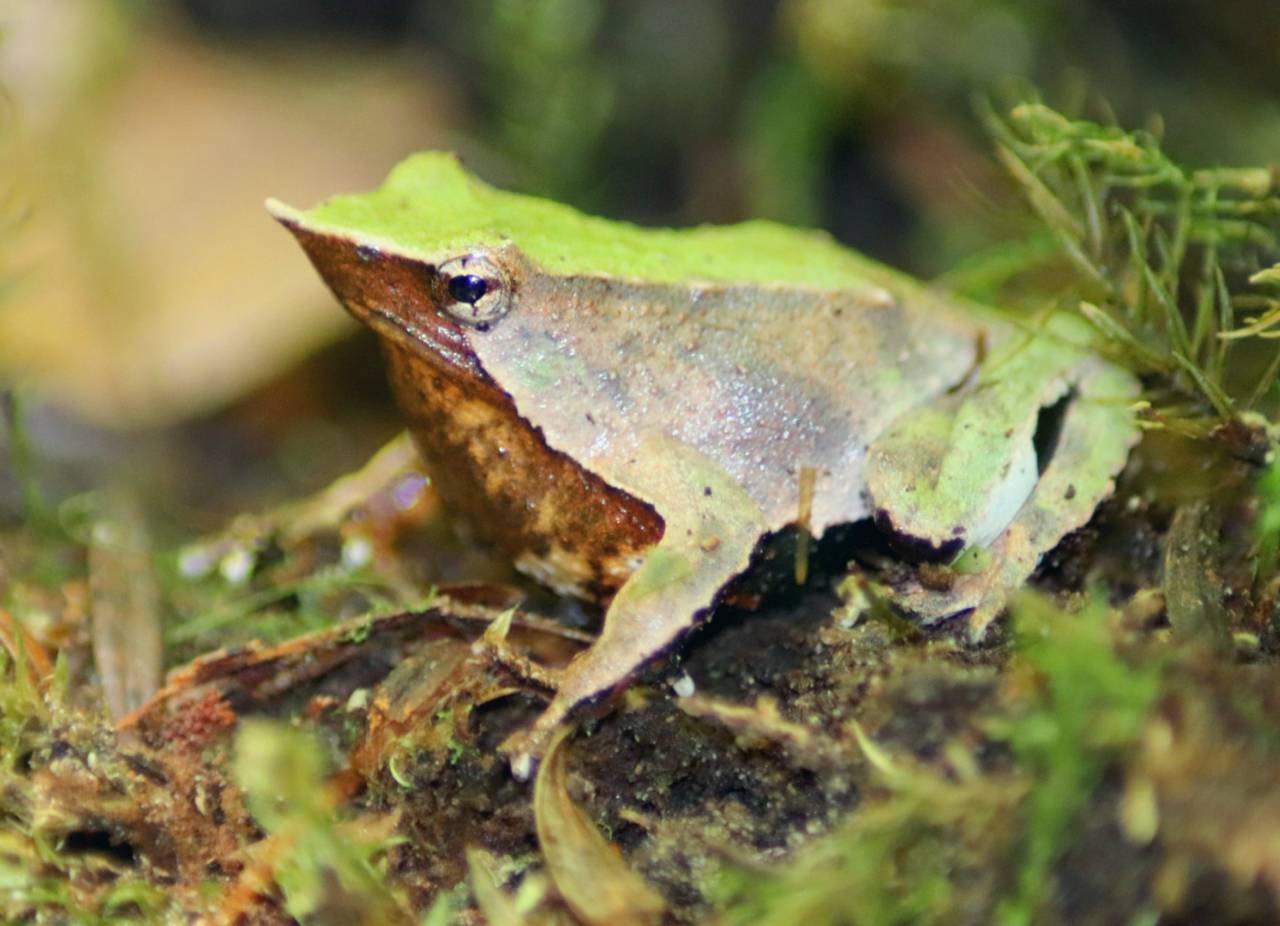Darwin’s Frog, scientifically known as Rhinoderma darwinii, stands out not only for its unique appearance but also for its fascinating reproductive strategy. Native to the forests of Chile and Argentina, this small amphibian is an incredible example of evolutionary adaptation. Let’s explore the intriguing world of Darwin’s Frog and discover what makes it a symbol of nature’s creativity.
Characteristics and Appearance
Darwin’s Frog is easily recognizable by its distinctive snout, which resembles a leaf, providing excellent camouflage among the forest floor’s detritus. This frog is relatively small, with adults reaching about 1 to 1.2 inches (2.5 to 3 centimeters) in length. Its coloration ranges from green to brown, helping it blend seamlessly into its leafy surroundings.
Habitat and Distribution
Darwin’s Frog inhabits temperate forests in southern Chile and Argentina. These frogs prefer cool, moist environments, such as those found near streams and under dense forest canopies. Their habitats are characterized by abundant vegetation and leaf litter, providing ample cover and feeding opportunities.
Diet and Feeding Habits
Darwin’s Frog primarily feeds on small insects and invertebrates that thrive in its lush forest habitat. Its diet includes ants, mites, beetles, and various other tiny arthropods. Employing a sit-and-wait strategy, these frogs utilize their excellent camouflage to remain hidden until prey ventures close. Once a target is in range, they strike with precision using their quick reflexes and sticky tongues to capture their next meal.
Darwin’s Frog Unique Reproductive Strategy
One of the most remarkable features of Darwin’s Frog is its unique reproductive strategy, known as “mouth brooding.” After the female lays eggs, the male guards them until they hatch. Remarkably, the male then scoops the tadpoles into his vocal sac, where they continue to develop in a safe and controlled environment.
Inside the vocal sac, the tadpoles undergo metamorphosis, eventually emerging as fully formed froglets. This adaptation protects the young from predators and environmental hazards, providing a greater chance of survival.
Egg Laying and Brooding
During the breeding season, typically occurring in the austral spring and summer, female Darwin’s Frogs lay between 20 to 40 eggs in concealed, moist sites near water. The male subsequently takes on the unique responsibility of guardian and caretaker, diligently watching over the eggs until they are ready to hatch. This incubation period usually lasts several days.
Mouth Brooding
Once the eggs hatch, the male Darwin’s Frog displays its remarkable adaptation known as “mouth brooding.” He carefully transfers the tadpoles into his vocal sac, providing a secure location where they continue their development. Within this protected chamber, the tadpoles undergo metamorphosis, transforming into fully developed froglets over the following weeks.
Froglet Emergence
Upon completing metamorphosis, the young froglets emerge from their father’s vocal sac, ready to embark on their independent lives within the forest. This brooding strategy offers substantial protection from environmental threats and predators, significantly increasing their chances of survival compared to external development.
Conservation Status
Darwin’s Frog is currently classified as vulnerable due to habitat loss, environmental changes, and the threat of disease, particularly chytridiomycosis. Conservation efforts focus on protecting their natural habitats and mitigating disease spread to preserve their populations for future generations.
FAQs About Darwin’s Frog
What makes Darwin’s Frog’s reproductive strategy unique?
The male Darwin’s Frog practices mouth brooding by carrying the developing tadpoles in his vocal sac until they metamorphose into froglets, offering them protection and enhancing survival rates.
Why is Darwin’s Frog named after Charles Darwin?
The frog was named in honor of Charles Darwin, who discovered it during his voyage on the HMS Beagle in the 1830s.
What is the primary habitat of Darwin’s Frog?
Darwin’s Frog resides in temperate forests in Chile and Argentina, favoring cool, moist environments with dense vegetation.
What conservation efforts are in place for Darwin’s Frog?
Conservation measures include habitat preservation, monitoring disease impacts, and research to understand and mitigate population decline.
How long do Darwin’s Frogs typically live?
Darwin’s Frogs have an average lifespan of about 10 to 15 years in the wild, assuming they are not heavily impacted by predators or environmental threats.
Can Darwin’s Frogs be kept as pets?
Due to their specialized habitat needs and conservation status, keeping Darwin’s Frogs as pets is not recommended. They require specific environmental conditions that are challenging to replicate in captivity.
What is the conservation status of Darwin’s Frog?
Darwin’s Frog is currently classified as vulnerable, primarily due to habitat loss, environmental changes, and diseases such as chytridiomycosis, which pose significant threats to their populations.
How does Darwin’s Frog’s camouflage help it survive?
The leaf-like snout and coloring enable Darwin’s Frogs to blend seamlessly into their environment, providing protection from predators by making them less visible in the forest floor’s leaf litter.
What specific adaptations do Darwin’s Frogs have for survival?
Aside from their camouflage, Darwin’s Frogs possess the unique adaptation of mouth brooding, where the male carries developing tadpoles in his vocal sac until they are ready to emerge as froglets, offering excellent protection during their most vulnerable stage.

